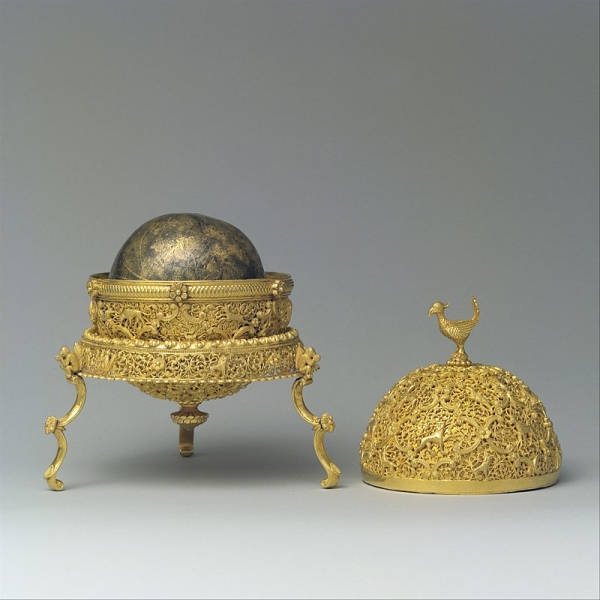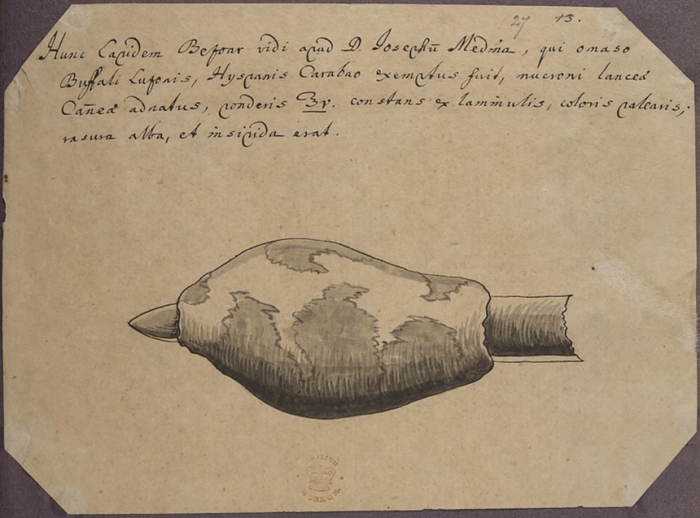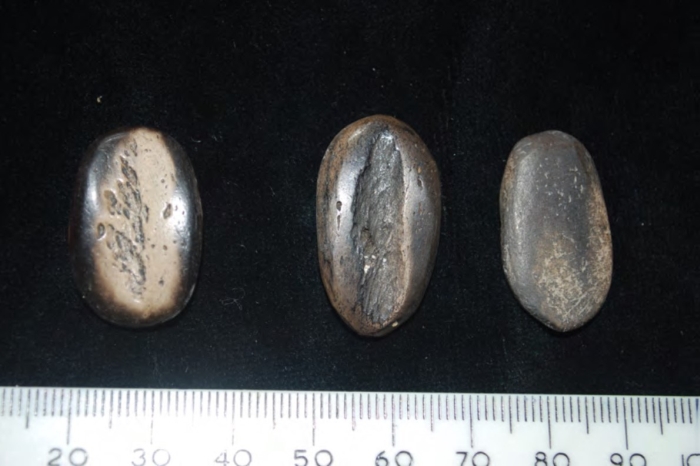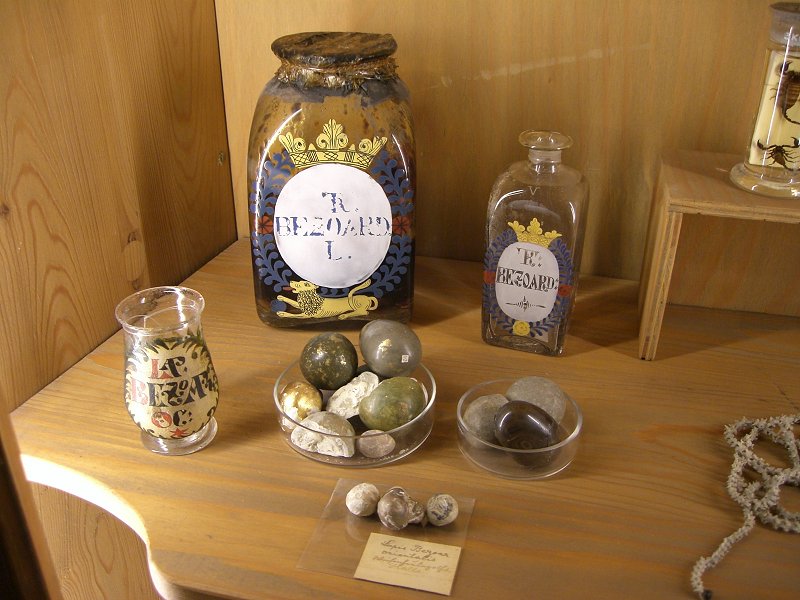For the Pacific Circle’s opening lecture of 2023 this past January, Dr Sebestian Kroupa presented his research on the Indo-Pacific networks that underpinned the global circulation of bezoars and other healing stones in the seventeenth and eighteenth centuries. This paper forms part of his current book project, titled Plants on the Move: The Making of Cross-Cultural Knowledge in Southeast Asia, c.1650–1750.
Sebestian is a Leverhulme Trust Early Career Fellow at the University of Cambridge and a Research Fellow at Wolfson College, Cambridge. His research is concerned with the histories of natural and medical knowledge in the early modern Indian and Pacific Oceans, with a particular focus on southeast Asia and the Spanish Empire. Sebestian has published on topics including Indigenous tattooing in the early Spanish Philippines (American Historical Review, 2022) and co-edited a special issue on “Science and Islands in Indo-Pacific Worlds” (BJHS, 2018). He is currently working on a monograph which examines how Philippine nature was constructed, commodified, and globalised in the early modern era.
RH: One thing that emerged very clearly from your paper was that the definition of a bezoar in the early modern period was incredibly unstable. You mentioned some of the wide variety of ‘healing stones’ of various origins that were identified as bezoars, as well as the multiple origin stories that tried to explain the origins of ‘true’ bezoars. And then there were debates over which stones had real medicinal value, whether stones from the Americas could be classed as bezoars, and whether pharmacists could manufacture artificial bezoars. So, what actually is a bezoar?
SK: Bezoars are stone-like concretions found in the gastrointestinal tract of different animals which used to be regarded as powerful antidotes and panaceas in different healing systems, including European, Islamic, Indian, and other traditions. In some places, like southeast Asia, bezoars remain in use today. Most people are probably familiar with bezoars from the world of Harry Potter, but bezoars have a long and convoluted cross-cultural history. Knowledge of bezoars was the result of centuries of cross-pollination between different cultures of healing. Their origin lies in the ancient Middle East: the word is derived from the Persian “pād-zahr” (پادزهر), which literally means “antidote”. The stones were unknown to Graeco-Roman antiquity but began to appear in Arabic texts from the eighth century. Arabic, Persian, and Hebrew scholars, practitioners, and traders carried bezoars to the Mediterranean and across the Indian Ocean and the Silk Road. Early modern European voyages put bezoars into even wider circulation, including the Atlantic and the Pacific. And concretions extracted from animal, plant, and even human bodies had been used for centuries in diverse Indigenous healing and spiritual practices around the world – whether under the influence of the bezoar tradition, or not.
Due to their healing powers, bezoars were highly sought after and became associated with élites across European and Indo-Pacific worlds. In nature, concretions found in animal viscera tend to be rather rare, and many bezoars were, in fact, forgeries. To make matters worse, scholars did not have a clear idea of the provenance of bezoars. Drawing on Islamic authors, European writers identified bezoars with goats or deer from mountainous regions in the East, Persia in particular. But the proliferation of long-distance links complicated any neat classifications, and practitioners and customers around the world were confronted with an ever-growing diversity of stones that could pass for bezoars. The Spanish found bezoars in the Americas in llamas, iguanas, and other beasts – the focus of Mackenzie Cooley’s excellent contribution to the beautiful upcoming volume Natural Things in Early Modern Worlds. Malay and Indian merchants distributed porcupine bezoars from Indonesia, Portuguese traders exported cow bezoars from Mozambique to Japan, and Protestant practitioners looked for bezoars at home in Europe as part of the backlash against so-called “exotic” imports. Some even began crafting artificial bezoars seeking to replicate or even surpass the powers of the natural stones, like those produced by the Jesuits in the Portuguese outpost of Goa. So, your question does not have a simple answer: bezoars meant different things to different individuals in different sites. They were embedded in animal viscera, diverse cross-cultural belief systems, and a highly variable nexus of relations between medicine, religion, magic, commerce, curiosity, imperialism, and power. And this instability makes them fascinating objects to follow.

© Metropolitan Museum of Art, New York
Your paper was framed around the collection and exchange networks of Georg Joseph Kamel, a Jesuit missionary stationed in Manila in the Spanish Philippines. This offers a fascinating glimpse of the place of healing stones in processes of cross-cultural and trans-oceanic trade and knowledge exchange, but of course Kamel was entering into a much older tradition of cross-regional connection and exchange in the Indian Ocean World of which bezoars and other healing stones were already a part. What do you see as the particular value of exploring this history of exchange in this early modern moment and through the lens of Kamel and his networks?
For me, this particular moment is interesting especially due to the rapid increase in the extent and intensity of cross-cultural interactions on a worldwide scale. In my work, I try to recover the variety of agencies across cultures, genders, and social spheres involved in the making of natural and medical knowledge amidst the early modern expansion of global interactions, which engendered the birth of science, medicine, and the modern world. I use Kamel’s networks and activities as a lens through which to examine these processes and understand how knowledge was produced, transformed, or effaced through negotiations between diverse actors. Kamel is, indeed, an extremely intriguing figure. His life was lived across the borders of empires and continents, cultures and languages, and confessions and knowledge traditions. He was born in the modern-day Czech Lands, where he was trained as a pharmacist by the Jesuits who subsequently dispatched him as a missionary to the Spanish outpost in the Philippines. Kamel’s access to Philippine nature turned him into a major agent in the worldwide network of knowledge exchange that extended from Mexico across the Philippines to England and traversed the boundaries of the Spanish Habsburg, English, Dutch, and Portuguese empires, as I describe in my recent article (Kroupa, 2016).
Kamel’s involvement in the bezoar trade specifically brings to life the dynamic interactions among the assorted cast of Jesuit drug dealers, Filipino noblemen and wisewomen, Chinese mandarins, European scholars, Persian goats, and Peruvian camelids. In the Indo-Pacific, seafarers and migrants had interlaced different sites across the two Oceans long before the European intrusion into the region. Yet early modern European voyages reopened lost connections, intensified existing relations, and created new links, which opened novel possibilities for different cross-cultural communities. European and non-European empires, religious orders, and Indigenous groups all jostled to take advantage of the newly opening horizons – and healing stones offer a great tool to follow these developments. Traders and consumers were involved in high-stake games of trust, fraud, and politics. Catholic missionaries, Hindu Brahmins, and Indigenous Filipinos invented secret recipes for powerful healing stones. Indigenous communities used their labour, creativity, and knowledge to claim their stake in the enterprise, but they were also confronted by colonial agents who worked to convert and appropriate Indigenous natural and spiritual worlds. These interactions shaped colonial frameworks with their hierarchies of power, patterns of labour, and understandings of knowledge and religion – the consequences of which continue to resonate to this day.

In your paper you talked about the influence of the trade in healing stones on the imagined geographies of the early modern Pacific. How did this play out?
In his treatise published in 1706 in the Philosophical Transactions, Kamel identified four kinds of true bezoars, all of which happened to be accessible from Manila: from Indo-Persian goats and monkeys, Indonesian porcupines, and Peruvian camelids. But drawing on the Islamic medical tradition, Kamel and most European authorities believed that true bezoars were by definition oriental bezoars, from Asia in the Far East. So how could Peruvian stones be true bezoars? European writers had quarrelled over Peruvian bezoars since the late sixteenth century, when Spaniards first introduced the stones as American, or occidental bezoars. The Spanish physician Nicolás Monardes defended his motherland’s interests by championing occidental bezoars over their oriental counterparts. By contrast, Portuguese authors considered occidental stones inferior substitutes for true bezoars, which could naturally only be found in Portuguese Asian dominions.
The stakes were high for the Jesuits, who traded in both Peruvian and Asian bezoars. In defence of Jesuit interests, Kamel offered a surprising solution: since by default occidental stones could not be true bezoars, Kamel defined Peruvian bezoars as oriental. If true bezoars were found in Peru, as Kamel’s research showed, then the country must be located in the Far East, the fabled source of powerful drugs. By contrast, Kamel claimed that the stones extracted from ruminants in the Philippines and Mexico were not true bezoars, just worthless replicas, and thus he designated them as occidental stones. Mexico and the Philippines – two sites joined by the Manila Galleon and endowed with the ineffectual occidental stones – were therefore located in the Far West. Ricardo Padrón’s excellent book, The Indies of the Setting Sun (2020), has shown how the Spanish sought to map East and Southeast Asia as mere westward extensions of Spanish American holdings. Early modern Pacific geographies were contested and shaped by political and commercial agendas. Kamel also saw Spanish America in continuity with Asia, but the decision where to draw the line between the East and the West was negotiable and, in his case, governed by histories of medicine and the drug trade.

© British Library, Sloane MS 4083C, f. 27r.
If you’ll forgive a rather awkward metaphor, it seems that, like the many onion-like layers of a bezoar, this project has many layers of interventions and historiographical significance. You’re intervening in Spanish and more broadly European colonial history by drawing attention to unexamined circuits of exchange and moments of cross-cultural exchanges and frictions; you’re intervening in global history by trying to shift the scholarship on trans-Pacific trade and early modern globalisation from a narrow focus on the silver, silk, and porcelain trade to incorporate these healing objects; and then there are contributions to the historiographies of the Philippines, the Jesuits, and early modern science and medicine. What do you see as the key interventions of this project?
My aim is to do justice to the wide range of voices that were involved – and silenced – in the making of knowledge and thereby contribute to more inclusive geographies of science, medicine, and globalisation. Historians tend to argue that global interactions were driven by commerce, religion, empire, or science. I try to show that these were not mutually exclusive forces and map out their highly variable interactions on the ground. Rather than lumping them together into one model of an entangled world, I am looking for a way to break down terms like ‘globalisation’ into more analytically precise processes that would do justice to my materials and historical actors. To trace these interactions, each of the five chapters of my book follows a different network and its distinct producers, consumers, and hierarchies of knowledge: the networks of empire, the drug trade, the Jesuits, the Republic of Letters – and, through the lens of bezoars, Indo-Pacific worlds. At the interstices of all these networks sits Georg Joseph Kamel in his workshop in Manila.
I use bezoars in particular to think about early modern Indian and Pacific Ocean histories and geographies, and the place of Manila therein. I use Manila as a lens to present the Indo-Pacific as a space of multiple overlapping networks and geographies. I seek to show that early modern histories of the Indian and the Pacific Oceans were less circumscribed by national, imperial, religious, and linguistic barriers than historians sometimes assume. Only by treating the two Oceans together can we fully capture the dynamics of knowledge making that shaped their shared histories. Yet importantly, the Indo-Pacific was not a single interconnected world in which people, knowledge, and objects moved around smoothly – but one in which knowledge travelled at specific times but not at others. Those are the patterns I am seeking to trace. The turn towards Indo-Pacific perspectives may also help us challenge the dominant narratives of colonial science and medicine which are largely modelled on the northern Atlantic and may naturally feed into the story of the rise of Western imperialism. In contrast, historiographies of the Pacific Ocean and Rim have placed emphasis on Indigenous genealogies and mobility and eschewed previous colonialist portrayals of the region as primitive and isolated – so these worlds have a lot to offer to historians of science and especially to those seeking to decentre Western histories.

© Royal Pharmaceutical Society Museum, London
Your paper follows bezoars, both the physical objects themselves and ideas about them, around the world. What was the research process like for this project? How did you find archival traces of these circulations?
This all began with a single shipping inventory held in the Archivo General de la Nación in Mexico. The register listed about two dozen items that Kamel sent from Manila across the Pacific to his fellow Jesuit pharmacist and compatriot in Mexico City, Johannes Steinhöffer. The majority of the items Kamel listed were actually various kinds of healing stones, including bezoars from Persia. This finding made me wonder how Kamel got hold of Persian bezoars from Manila, why he went to such great lengths of shipping them across the Pacific, and what happened to them in Mexico. It turned out that Kamel devoted lots of attention to various kinds of healing stones and especially bezoars in his treatises on Philippine nature – including their roles in Indigenous practices.
As I was seeking to follow these traces, I went down a rabbit hole and began encountering these stones everywhere: in missionary histories and dictionaries, Inquisition records, travel accounts, medical treatises, collection inventories, etc. A letter held in Brno, in Kamel’s native Czechia, described how he sent Philippine snake stones, artificial antidotal concretions produced by Indigenous communities in the Philippines, to another of his friends in Mexico. In the Jesuit archives in Rome, I consulted a manuscript collection of Portuguese recipes from Goa and Macau, among other places, which detailed how Jesuit missionaries produced artificial bezoars. One of the makers of one of these stones happened to be Kamel’s correspondent, while the key ingredient in another recipe turned out to be a Philippine medicinal seed widely promoted by Kamel. Last but not least, the stones left their material traces, and many survive in collections to the present day. There are bezoars in the Viennese Kunstkammer, snake stones in the Royal Pharmaceutical Society Museum in London, Goa stones in the MET. In Indonesia and India, you can still buy porcupine bezoars and snake stones, respectively. This materiality offers additional methodological lenses and opens further avenues of enquiry. Even so, I am finding myself still only scratching the surface. For example, we know rather little about the uses and movements of bezoars and other healing stones in Indian Ocean worlds prior to the European arrival. Sadly, I do not read Arabic, Farsi, Malay, or Indian languages, so that is a research project for someone else. The Chinese and the Japanese contexts could also be interesting to look at. If anything, bezoars and their complex cross-cultural trajectories open up countless new research avenues.

